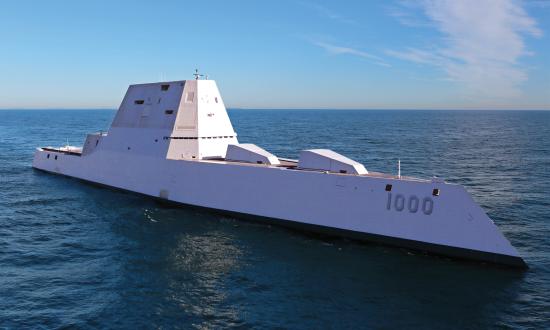The United States needs a seaborne option for suppression of enemy air defenses (SEAD)—as quickly as possible.
The ability of the U.S. military to penetrate and dominate contested airspace—one of its hallmarks for many decades—is in question. Russia and China’s continuous improvement in electronic warfare and area-denial systems are serious obstacles to U.S. power projection.
U.S. involvement in conflicts over the past 50 years attests to the importance of disabling and/or destroying enemy air defenses, in the interest of both protecting personnel and gaining ground. SEAD—or “Wild Weasel” operations, as they were once known—encompasses the use of specialized tactics and weapons designed to take down air defenses quickly, either permanently or long enough to press an advantage. SEAD capability is particularly vital to U.S. tactics and operations, with air superiority being the domain in which the United States holds the most decisive advantage over its foes. It is a necessary condition for U.S. victory in most potential conflicts.
Any U.S.-China conflict most likely would occur in the South China Sea, in reach of China’s heavily defended coastline. Recognizing the capability of the U.S. military in air combat and airstrikes, the People’s Liberation Army (PLA) has taken great pains to offset this advantage. With the largest intermediate-range missile arsenal in the world, China has developed the ability to keep both U.S. aircraft and the aircraft carriers from which they deploy far from the fight.
The Naval Integrated Fire Control–Counter Air (NIFC-CA) model integrates high-performance aircraft into a joint strike system, with stealth-capable sensor craft such as the F-35B/C acting as forward observers for more SEAD-oriented strike craft such as the F/A-18E/F Super Hornet and EA-18G Growler. In the face of a layered antiaircraft defense, NIFC-CA would employ all or nearly all mission-capable craft from a carrier to overwhelm the foe with electronic and kinetic attack. However, should such an attack fail, the majority of the carrier’s capabilities would be expended, with the potentially devastating concomitant loss of aircraft and aircrew. Worse, the NIFC-CA concepts rely on networked communications successfully resisting Chinese cyber and electronic warfare capabilities. A well-executed cyber attack could cripple communications among aircraft, isolating them and severely limiting effectiveness and survivability.
The United States needs a self-contained SEAD option that can be deployed over distances exceeding those of strike aircraft—something cheap, easily produced, and able to punch holes in China’s air defenses long enough for more conventional forces to be used effectively. It also should possess the flexibility to track changing or evasive targets.
Time to Kill
A possible solution would be to develop a SEAD loitering munition—purpose-built for use in littorals. A ground-effect optimized loitering munition (essentially a small wing-in-ground effect [WIG] vehicle—see “Modern Sea Monsters,” pp. 26–31, September 2020) would offer numerous advantages against advanced air defenses. Compared with a more conventional weapons system, a WIG loitering munition would boast greater endurance, low-cost stealth capability, and maximum flexibility in use, whether from land or sea. Not a wild weasel, in other words, but an otter.
A loitering munition is for all technical purposes a drone, except that, unlike the MQ-9 or similar craft, it is not meant to return from a mission. Instead, like a cruise missile, when it reaches a target, it detonates a warhead. To date, U.S. investment in such weapons has been limited to small units such as AeroVironment’s Switchblade (about 5 pounds total weight) or Raytheon’s Coyote (about 12 pounds). Other nations have demonstrated the effectiveness of much larger ones, such as the Israeli Aircraft Industries’ Harpy, which carries a 32-kilogram warhead.
The key advantages of loitering munitions over other weapon types, especially cruise missiles, are the ability to launch then wait until an opportunity to strike presents itself and the option to change targets or routes midflight. With the high mobility of PLA surface-to-air missile (SAM) systems, the ability to reroute is vital, particularly since the simple tactic of intermittently turning off radar makes it fairly easy for a ground radar to move before a targeting solution can be created. A loitering munition can operate closer to a likely target area and respond faster than a missile fired from a destroyer 800 miles away.
To reduce the risk of detection, loitering munitions ought to operate at low altitude. Normally, there is a penalty to be paid in fuel use for low-altitude flight, but operation in ground effect mitigates this. WIG vehicles are craft built to optimize the use of ground effect: a circumstance in which airfoil-generated lift is significantly augmented (and induced drag reduced) by proximity to a surface. Using ground effect, a loitering strike munition’s range would be much greater than that of a comparable aircraft at a higher altitude. The highest endurance loitering munitions today have operational limits of around six hours or 550 nautical miles. But an Air Force Institute of Technology study suggests a manned craft in ground effect would use five times less fuel than one intended for out-of-ground-effect flight. Even a more conservative estimate of three times less fuel would extend the range of existing weapons to and even beyond that of Tomahawk land-attack missiles.
How Low Can You Go?
The strongest ground effect is felt at an altitude about half a craft’s wingspan. A WIG loitering munition with a 10-foot wingspan would need to travel (or at least loiter) within just 5 feet of the ground. Surprisingly, this is less of a challenge than it seems. The Naval Strike Missile (NSM) can skim the sea at an altitude that can be measured in inches. Like the NSM, a low-altitude loitering munition would benefit from the stealth inherent in flying well below most electromagnetic detection systems until extremely close to the target. Unlike the NSM, a turboprop-powered loitering munition would be limited to a cruise speed of 120–150 knots—similar to many UAVs. However, as recent conflicts in the Middle East have demonstrated, even slow drones are quite capable of penetrating advanced air-defense systems.
The RAND Corporation report Drone-Era Warfare Shows the Operational Limits of Air Defense Systems (July 2020) offers examples of drone and loitering munition strikes that have proven effective. They have evaded air-defense systems as sophisticated as the Russian-built Pantsir, S-300, S-400, and Buk-M1 SAM systems. Libyan Government of National Accord, Turkish, and Israeli forces have repeatedly succeeded in destroying the air defenses of rivals with drones and loitering munitions playing a major role in SEAD tactics. Only the vast distances in the Pacific and the South China Sea argue against such tactics, but wing-in-ground effect endurance opens the door there.
Further, low-speed operation in ground effect would make water landings and take-offs feasible. With the capability to float, the operational timeframe of the unit increases from hours to days and enhances the munition’s usefulness as a flexible strike option. Engineering students at the University of St. Petersburg produced a completely solar-powered WIG drone of considerable size capable of 107 knots, as well as water landing and take-off—demonstrating, if nothing else, the endurance and efficiency capability of WIG craft. Lacking a cockpit, a loitering munition at rest on the water would be nearly invisible to all forms of detection, exhibiting almost no radar profile.
A risk to the utility of ground-effect munitions would be a loss of the element of surprise, thanks to its restriction to low altitude. However, because a low-altitude munition would use completely different antidetection strategies than other U.S. aircraft, it would pose a particular challenge for a defender to counter. A defender would be forced to choose either to allocate antiaircraft artillery (which is fairly spare in modern militaries) to low-altitude defense or sit on a hair trigger to use missile defenses. Either way, the enemy focus would be split between defending against an extremely low-altitude threat and an extremely high-altitude threat, reducing the ability to mount a defense against either.
The United States faces the very real possibility of a coastal conflict on the other side’s home turf. The value of a weapon that can strike from the sea suddenly, decisively, and without risk of losing a single U.S. warfighter should not be overlooked. The flyaway cost to replace carrier-launched aircraft ranges from $65 to $95 million. The development of sacrificial units to soften up enemy defenses and increase aircraft survivability should save money and lives. The combination of concepts may be novel, but the constituent technologies are preexisting. The real threat is whether our enemies are ready to exploit these ideas before we are.






